- Clinical Technology
- Adult Immunization
- Hepatology
- Pediatric Immunization
- Screening
- Psychiatry
- Allergy
- Women's Health
- Cardiology
- Pediatrics
- Dermatology
- Endocrinology
- Pain Management
- Gastroenterology
- Infectious Disease
- Obesity Medicine
- Rheumatology
- Nephrology
- Neurology
- Pulmonology
Incomplete LV Rupture Secondary to MI: A Case of Intramyocardial Dissection
Myocardial rupture is the most feared and often lethal complication of acute MI. It was a potential diagnosis for this patient who presented with sinus tachycardia, ST-segment elevation from V1 to V4, II, III, and aVF with associated Q waves. Follow the workup and outcome here.
Figure 1. Admission electrocardiogram revealing significant ST-segment elevation in the precordial and inferior leads, with associated Q waves, consistent with recent acute MI.
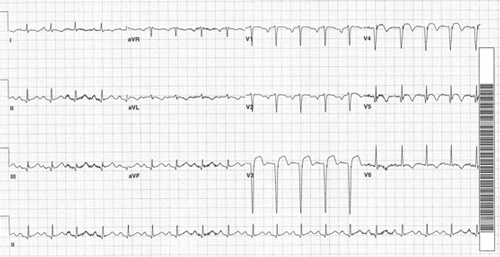
Figure 2. Coronary angiograms showing the left anterior descending coronary artery before (single arrow) and after successful stenting (arrow heads) with a bare metal stent; in the cranial (panel A and B) and caudal (panel C and D) angulation views. Note the left circumflex coronary artery without significant disease and the large LAD vessel after revascularization (arrow heads).
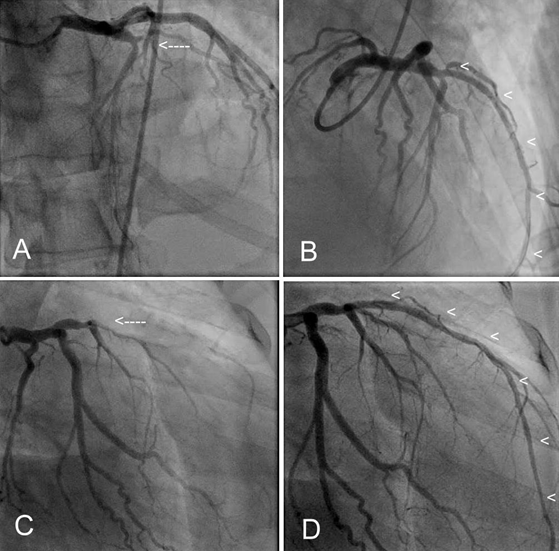
Figure 3. Echocardiographic views (A. Parasternal long axis view; B. Apical 2-chamber view; C. Apical 4-chamber view; D. Parasternal short axis view of the left ventricle) revealing an apical dilatation of the left ventricle (see*), with small mobile intraventricular densities (arrow head) suggestive of a left ventricular aneurysm or a pseudoaneurysm.
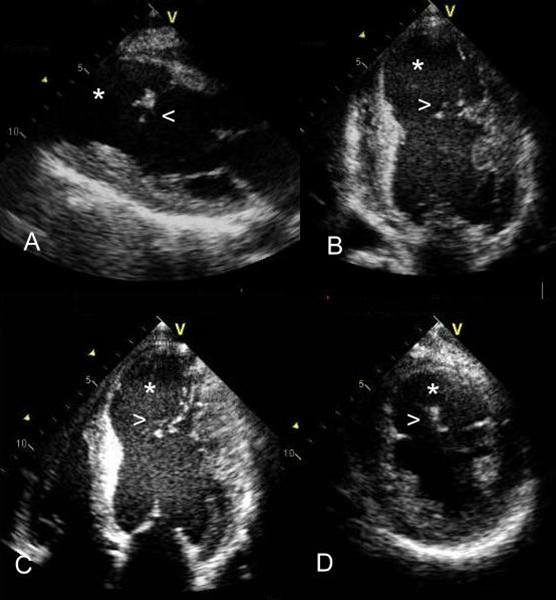
Figure 4. Sagittal and coronal MRI cuts of the left ventricle showing significant thinning of the left ventricular wall and dilatation of the left ventricular apex (arrows), confirming the presence of a true aneurysm of the left ventricle.
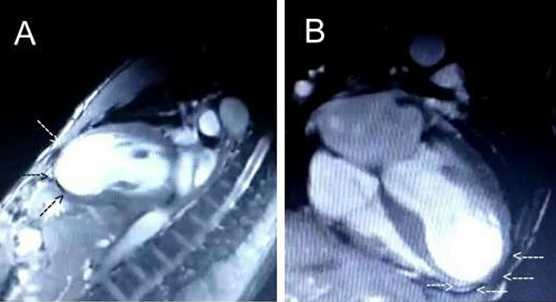
Figure 5. Sequence of events after acute MI that lead to the loss of left ventricular wall integrity and intramyocardial dissection and development of a large anterior septal and apical aneurysm. A. Left ventricle showing endocardial and myocardial layers with areas of infarction. B. Open arrows show the point of wall disruption and the splitting in two of the myocardial wall. C and D. Schematic drawing and correlated echocardiographic image, revealing the aneurysmatic dilatation (see*) and hanging myocardial/endocardial wall in the left ventricle (intramyocardial dissection with incomplete LV rupture) as a result of acute anterior wall ST-segment elevation MI.
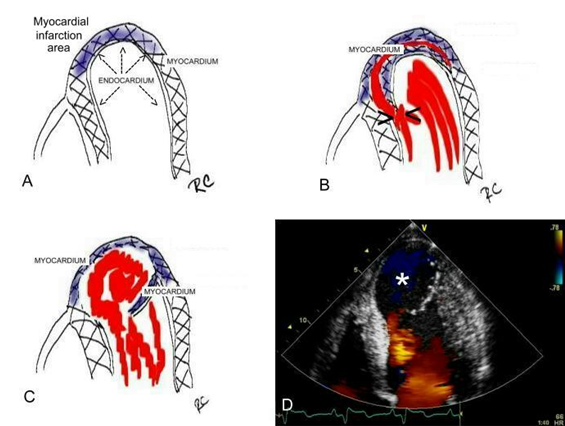
Dr Gonzalez is a resident and Dr Castillo is an attending physician in the department of medicine, cardiology division, at Brookdale University Hospital and Medical Center in Brooklyn, New York. Dr Ramkissoon is a cardiovascular fellow in the department of medicine at SUNY Downstate Medical Center in Brooklyn, New York.
Case History
A 53-year-old man with a history of hypertension presented to the emergency department complaining of a week-long history of intermittent retrosternal chest discomfort. The pain had worsened 8 hours before admission. Chest pain was of 4/10 in severity and was associated with dyspnea and palpitations.
Admission blood pressure was 180/106 mm Hg; pulse, 121 beats/min; respiration rate, 22 breaths/min. There was no significant jugular venous distention, but bilateral crackles were noted in both lungs.
The ECG revealed sinus tachycardia and ST segment elevation from V1 to V4, II, III, and aVF with associated Q waves. These findings were consistent with a recent acute anterior wall ST-segment elevation MI (Figure 1).
The patient had no history of tobacco addiction, alcohol consumption, or illicit drug use. Pertinent admission laboratory tests showed that levels of troponin, creatinine, electrolytes, and hemoglobin were within normal limits.
Emergent cardiac catheterization revealed total thrombotic occlusion of the mid left anterior descending coronary artery (Figure 2A and 2C). The remaining coronary arteries revealed only luminal irregularities; left ventriculography showed a severely decreased left ventricular ejection fraction of about 15%. Successful manual thrombectomy followed by bare metal stenting was performed (Figure 2B and 2D).
Transthoracic echocardiogram (TEE) confirmed the severely depressed left ventricular ejection fraction and showed an apical dilatation of the left ventricle, with small, mobile, intraventricular densities that suggested loose myocardial tissue at the margins of the anterior and septal walls. This suggested a left ventricular aneurysm (LVA) or a pseudoaneurysm (PA) (Figure 3). Contrast echocardiography and cardiac CT angiography failed to distinguish between an LVA and a PA. Cardiac magnetic resonance (CMR) was therefore requested: this confirmed an LVA (Figure 4) with myocardial tissue hanging in the LV cavity, consistent with intramyocardial dissection of the LV anterior, septal, and apical myocardial walls (Figure 5).
The patient was discharged after 7 days of an uneventful hospitalization course, during which he was treated with prophylactic anticoagulation and afterload reducing agents. He was followed up in the outpatient clinic at 30 days and 3 months without re-hospitalization and with compensated, stable congestive heart failure.
Discussion
Myocardial rupture is the most feared and often lethal complication of acute MI.¹ Free-wall rupture usually occurs 3 to 6 days after MI and is mostly associated with anterior wall MI. Rupturing of the free wall of the infarcted ventricle is relatively common, and is found in 15% to 25% of patients who died of MI.2-4 Myocardial rupture is found in fewer than 1% of living patients with an acute MI.5
Incomplete rupture is a relatively uncommon type of free-wall rupture, found in 10% to 15% of total free-wall ruptures.6
It is thought that the infarcted myocardium wall is made weak in part by activation of metalloproteinases, which degrade the myocardial matrix. Structural weakness associated with increased intracavitary pressure predisposes the myocardial wall to rupture.
Smaller transmural MIs with conserved myocardial contractility are more prone to rupture than bigger transmural MIs, with decreased myocardial contractility. This could be related to the higher intracavitary pressure reached during systole in patients with preserved ejection fraction.7
The absence of collateral blood flow and size of the infarct area are important determinants of the likelihood of myocardial rupture. No previous history of angina or MI and ST-segment elevation or Q-wave development on the initial ECG increase the likelihood of free-wall rupture, as seen in our patient. Other risk factors include anterior wall infarct; increased age; female sex; early ambulation; and recent use of thrombolytics, corticosteroids, and NSAIDs. Thrombolytic therapy administered more than 11 hours after the onset of symptoms may increase the risk of cardiac rupture. In contrast, if thrombolysis is administrated within 6 to 7 hours of symptoms onset, risk is reduced. Beta-blockers, percutaneous coronary intervention, and left ventricular hypertrophy also reduce the risk of free-wall rupture.8,9
Cardiac hypertrophy may have protected our patient from complete free-wall rupture. The lack of early reperfusion therapy and medical treatment predisposed him to the development of left ventricular aneurysm, so that the myocardium of the anterior and septal wall split in half: the more inner part of the wall hung into the ventricular cavity, which resulted in an incomplete rupture of the LV myocardial wall and the dissection of the myocardium in the infarcted area
It was difficult to differentiate if the apical dilatation was a true LVA or PA on the initial TTE. Pseudoaneurysms are only contained by adherent pericardium: these have a 30% to 45% risk of rupture, and a mortality rate of 50% when treated medically. Hence, surgery is the preferred treatment option. With current techniques, perioperative mortality is less than 10%.10
In comparison LVA is a well-delineated, thin, scarred or fibrotic wall, which rarely ruptures. Hence, medical therapy is the preferred option. Affected patients are at risk for heart failure and arrhythmia, however.
While TTE has it advantages (low cost and readily available) over CMR, the sensitivity to diagnosis of subacute free-wall rupture is about 70%.11 Our patient was hemodynamically stable and did not develop any arrhythmias; hence it was safe to proceed with CMR for an accurate diagnosis. CMR can be used to differentiate a true LVA from a PA. It is used to evaluate flow disturbances between the cavity, LV, and pericardium.12
In summary, we present a case in which an acute MI led to intramyocardial dissection and workup for LVA vs PA. CMR is the definitive imaging modality to evaluate clinically stable patients with echo findings that suggest possible free-wall rupture. It is hoped that with early reperfusion therapy, the incidence of this feared complication will continue to decrease.
ã
References:
- Reeder GS. Identification and treatment of complications of myocardial infarction. Mayo Clin Proc. 1995;70:880.
- Reddy SG, Roberts WC. Frequency of rupture of the left ventricular free wall or ventricular septum among necropsy cases of fatal acute myocardial infarction since introduction of coronary care units. Am J Cardiol. 1989;63:906-911.
- Stevenson WG, Linssen GC, Havenith MG, et al. The spectrum of death after myocardial infarction: a necropsy study. Am Heart J. 1989;118:1182.
- Pohjola-Sintonen S, Muller JE, Stone PH, et al. Ventricular septal and free wall rupture complicating acute myocardial infarction: experience in the Multicenter Investigation of Limitation of Infarct Size. Am Heart J. 1989;117:809.
- Becker RC, Gore JM, Lambrew C, et al. A composite view of cardiac rupture in the United States National Registry of Myocardial Infarction. J Am Coll Cardiol. 1996;27:1321.
- Slater J, Brown RJ, Antonelli TA, et al. Cardiogenic shock due to cardiac free-wall rupture or tamponade after acute myocardial infarction: a report from the SHOCK Trial Registry. Should we emergently revascularize occluded coronaries for cardiogenic shock? J Am Coll Cardiol. 2000;36:1117e1122
- Tao ZY, Cavasin MA, Yang F, et al. Temporal changes in matrix metalloproteinase expression and inflammatory response associated with cardiac rupture after myocardial infarction in mice. Life Sci. 2004;74:1561–1572.
- Becker RC, Hochman JS, Cannon CP, et al. Fatal cardiac rupture among patients treated with thrombolytic agents and adjunctive thrombin antagonists: observations from the Thrombolysis and Thrombin Inhibition in Myocardial Infarction 9 Study. J Am Coll Cardiol. 1999;33:479-487. PubMed PMID: 9973029.
- Becker RC, Charlesworth A, Wilcox RG, et al. Cardiac rupture associated with thrombolytic therapy: impact of time to treatment in the Late Assessment of Thrombolytic Efficacy (LATE) study. J Am Coll Cardiol. 1995;25:1063-1068. PubMed PMID: 7897117.
- Frances C, Romero A, Grady D. Left ventricular pseudoaneurysm. J Am CollCardiol. 1998;32:557-561. Review. PubMed PMID: 9741493.
- Lopez-Sendon J, Gonzalez A, Lopez de Sa E, et al. Diagnosis of subacute ventricular wall rupture after acute myocardial infarction: sensitivity and specificity of clinical, hemodynamic and echocardiographic criteria. J Am Coll Cardiol. 1992;19:1145-1153.
- Mollet NR, Dymarkowski S, Volders W, et al. Visualization of ventricular thrombi with contrast-enhanced magnetic resonance imaging in patients with ischemic heart disease. Circulation. 2002;106:2873-2876.
